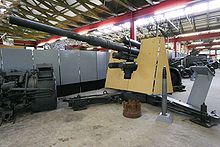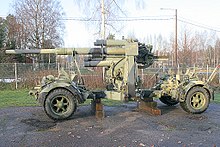8.8 cm FlaK 18/36/37
| 8.8 cm FlaK 18/36/37 | |
|---|---|
|
|
|
| General Information | |
| Manufacturer country: | German Empire |
| Developer / Manufacturer: | Croup , food |
| Development year: | 1920s |
| Production time: | 1933 to 1945 |
| Number of pieces: | 20,754 |
| Model variants: | FlaK 18, 36, 37 |
| Weapon Category: | Anti-aircraft gun |
| Technical specifications | |
| Caliber : |
88 mm |
The 8.8 cm FlaK 18/36/37 , also known as the eight-eight or eight-eight , was a German anti-aircraft gun that was mainly built and used during the Second World War and was also often used against ground targets.
development
The forerunners of the weapon go back to the First World War . The ground-based weapons of that time could no longer reach the ever higher flying aircraft. This is why the 8.8 cm SK L / 45, which was already used by the Navy as flak on ships and on land by the Marine Corps Flanders and in sea fortresses , became the 8.8 cm Flak 16 (also known as 8.8 cm K .Zugflak L / 45 labeled). Due to the war, this weapon was only used in small numbers.
The Versailles Treaty banned the German Reich from developing and producing numerous types of weapons, including heavy artillery . However, this ban was often circumvented by German scientists and members of the Reichswehr going abroad, including to the Soviet Union . The Krupp AG sent - after the acquisition of shares in the Swedish company Bofors end of the 1920s - a group of engineers in Sweden. At that time, this company was very active in the field of anti-aircraft weapons. A new cannon with a caliber of 75 millimeters was initially built there , which was later enlarged to 88 millimeters. From 1933 this model was produced in series as FlaK 18 in Essen. Other manufacturers were the Krupp subsidiary Grusonwerk in Magdeburg-Buckau , Hering ( Neustadt in Saxony ), Gebrüder Böhler ( Kapfenberg ), Voith ( Heidenheim / Brenz ), Werleim & Co ( Vienna ), the Škoda-Werke in Pilsen and Dubnica , MAN ( Augsburg ) and the Berlin-Erfurt machine factory .
In the case of German weapons, the number usually denoted the year of construction or introduction to the troops (see also 08/15 (phrase) ). For reasons of secrecy, however, all weapons that were developed at the time of the armaments restriction from 1920 were given the model designation 18.
description
The first version was the semi-automatic FlaK 18 , a gun with a barrel return . It had a one-piece gun barrel with a hydropneumatic barrel return brake located above the barrel. The tube had a length of 56 calibers and a screw-down base with a cross wedge lock that was operated with a crank handle. As a semi-automatic, the breech opened automatically after the shot when the barrel advanced, ejected the empty cartridge case and tensioned the mainspring. The weapon was ready to be loaded, which allowed a well-rehearsed team to fire around 15 to 20 rounds per minute.

Like its predecessor from World War I, the weapon had a cross mount . This allowed a rotation of 360 °, which was only possible with an ordinary artillery weapon by repositioning the mounts. For transport, the two side arms of the cross were folded up and each of the two ends of the carriage was placed on a single-axle trailer (both together formed the special trailer 201 ), with the tube pointing in the direction of travel.
Since the rear part of the barrel is usually the most stressed due to the ignition of the propellant charge, the improved FlaK 36 was given a three-part barrel. This meant that the entire tube did not always have to be replaced, only the worn part. Later weapons received improved limbs (special trailer 202) .
The FlaK 37 largely corresponded to the FlaK 36 with an improved transmission of target data from the command unit to the actual weapon.
In addition to the standard carriage mentioned, there were also a number of other modifications, including special platforms for railroad cars , various self-propelled guns and a shield for use in ground combat. However, this offered the operating team only limited protection and also enlarged the silhouette of the weapon.
All three versions were very similar and it did happen that assemblies of one version were built into another. Decisive for the designation was the carriage cross, d. H. a FlaK 18 mount with a FlaK 36 barrel was designated as FlaK 18 .
Despite the appearance of the 8.8 cm FlaK 41 (a completely new development with 74 caliber lengths), the older versions were built until the end of the war. With the FlaK 37/41 an attempt was made to match the performance of the earlier 8.8 cm FlaK with those of the FlaK 41 . In addition, the guns were given longer barrels with muzzle brakes as well as a fuse setting machine and loading device for FlaK 41 . However, it was a stopgap measure of which only a few copies were built.
Technical specifications
| Parameter | Data |
|---|---|
| Length in firing position | 7,620 mm |
| width | 2,305 mm |
| height | 2,418 mm |
| Pipe length | 4,930 mm (L / 56) |
| caliber | 88 mm |
| Mass in firing position | 5,000 kg |
| Mass in transport position | 7,400 kg (including Sd.Anh. 201 and protective shield) |
| Pipe elevation | −3 ° to + 85 ° |
| Swivel range | 360 ° |
| Muzzle velocity | 820 m / s (HE shell) |
| 795 m / s (tank shell) | |
| Bullet mass | approx. 9.4 kg |
| maximum firing range | 14,860 m |
| maximum shot height | 10,600 m |
| practical rate of fire | 15-20 rounds / min |
commitment
During World War II it was used on practically all fronts, with a battery usually containing four guns . The highest number of operational 8.8 cm FlaK 18/36/37 was reached in August 1944 with 10,704 units.
Used in the Spanish Civil War and in the German Wehrmacht
The weapon was first used in the Spanish Civil War . There it was also tested for the first time in the role of an anti-tank gun, and the advantages and disadvantages of the 8.8 cm anti-aircraft gun in its role as an anti-tank weapon were already visible. Experience led to the introduction of a two-part gun barrel and a more robust tractor.
Gun operation 8.8 cm FlaK
On this anti-aircraft gun, nine men were usually deployed as an operating team for the following tasks (K = gunner ):
- K1: Elevation gunner
- K2: side gunner
- K3: loading gunner
- K4 and 5: ammunition gunners
- K6: ignition controller
- K7 and 8: ammunition gunners
- K9: Gun leader / flak commander
The 8.8 as an anti-tank gun
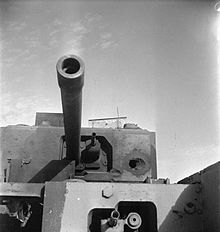
Their legendary reputation acquired the 8.8 less in their role as anti-aircraft gun as by their use in ground combat, in which, in some cases with their time fuse explosive shells as a howitzer, but above all as a tank gun in the anti-tank was used. In contrast to most of the other heavy anti-aircraft guns, the 8.8 could also be aimed below the horizontal (negative elevation angle ) and thus shoot targets directly from an elevated position.
As part of the western campaign in the early summer of 1940, Allied tanks under General Weygand attacked the German lines in the Battle of Abbeville . It turned out that only the Eight-Eight could penetrate the armor of the heavily armored British Matilda II tanks . The 57th Infantry Division managed to stop the advance. The Germans used this defense technique again four years later - in retreat - after the Allies landed in Normandy (for example on July 18, 1944 during the attack of Montgomery east of Caen in the course of the Battle of Caen ). Some port cities on the Atlantic were secured with many 8.8 (for example Brest , Lorient and St. Nazaire with their submarine bunkers ); they too defended themselves with 8.8 against attacking Allied tanks (see Battle of Brittany ).
When at the beginning of the war against the Soviet Union the standard anti-tank gun PaK 36 and the guns of most tanks against the Soviet tanks T-34 and KW-1 were only successful at an extremely short distance, the 8.8 cm anti -aircraft gun was often the only available weapon that could destroy enemy tanks from a great distance - up to 2000 m. From March 1941, the Africa Corps fought in North Africa (Africa campaign ). This showed the importance of the eight-eight as an armor-piercing weapon that could fight the Allied tanks in the clear terrain from distances that were beyond the range of their on-board weapons. She was able to use her advantage particularly in open terrain. In heavily fragmented terrain, such as after the Allied landings in Normandy , it was less successful. Disadvantages for their use at the front, however, were the high shape and the relatively high weight of the weapon.
In mid-1944 almost 11,000 types 18, 36 and 37 were in service with the Wehrmacht . In October 1944 alone, more than 3.1 million shells were fired with these guns . The importance of the weapon is also made clear by the fact that a third of all cannon barrels manufactured in Germany that year were intended for the eight-eight. Captured copies were also used by the British Army and the US Army , which even had its own manual printed in English. The Red Army also used captured cannons or cannons that had been delivered to the still-friendly Soviet Union before the war. After the end of the war, the weapon was in service in Yugoslavia and Finland for many years.
The 8.8 as the cannon of the tiger
Due to its high penetration power, the 8.8 cm FlaK was selected in a slightly modified form as the 8.8 cm KwK 36 (L / 56) combat vehicle cannon, also as armament for the VI Tiger armored vehicle, of which 1,350 were built. For this purpose, the weapon was switched to electric ignition and fitted with a muzzle brake .
The 8.8 on Panzerkampfwagen IV
As part of the development of flak tanks, the 8.8 cm Flak 18 & 37 were mounted on a chassis of the Panzer IV in 1942. The structure of the tank was slightly modified accordingly. Series production was refrained from. In contrast to some other self-propelled guns, the version with the Flak 18 installed had no fold-out side walls or shield. Only the version of the special chassis with Flak 37 had this.
The 8.8 on Sd. Vehicle 8, ZgKw 12 t
In the years 1939/40 at Krupp on the basis of Sd.Kfz. 8 (DB 9 chassis) built around 25 self-propelled guns with modified 8.8 cm Flak 18 for firing ground targets. These were used by the 1st Company of Panzerjäger-Department 8 during the French campaign. This unit was also used in the campaign against the Soviet Union. There it was renamed to Panzerjäger-Company 601. In August 1942 it was renamed again, this time to 3rd Company Panzerjäger-Department 559 (Sfl). By March 1943 all vehicles had been used up.
The 8.8 on Sd. Vehicle 9, ZgKw 18 t
In 1942 the order was placed to procure 112 self-propelled guns for the 8.8 cm Flak 37. The Sd.Kfz. 9 (heavy towing vehicle 18 t) from Vomag based first test model was completed at the end of October 1942. Twelve series vehicles of this as 8.8cm Flak 37 (Sf.) On p. Zgkw. Vehicles designated as 18t were actually delivered between July and September 1943. The armored structure consisted of 14.5 mm thick armor sheets. The assembly was carried out at the ironworks Weserhütte in Bad Oeynhausen. 40 grenade cartridges could be accommodated in the containers at the stern. Two supports per side had to be folded out to stabilize the fire. Because the weight had increased to 25 t, stronger spring bars had to be built into the chassis. All twelve production vehicles were assigned to the 26th Panzer Division, where they were used in the Association of Heeres-Flak-Department 304 from 1943 to 1945 in Italy.
The 8.8 on VOMAG trucks
The gun car version carried the base for the 8.8 cm flak on the central platform. The main weapon was the 8.8 cm Flak 18, but usually with the multi-part barrel of the 8.8 cm Flak 36. All guns still had the automatic loading system, which was not used. The side walls could be opened and additionally provided with a railing. The walls were locked in the driving position using simple bolts. Here, too, one support per side as well as at the front and rear of the vehicle was folded out for stabilization when firing.
Use against the HMS Sikh
When the British forces attempted to land near Tobruk (Libya) on September 14, 1942, the destroyer HMS Sikh was hit by the anti-aircraft guns. I./43 (Major Wegener) taken under fire. The HMS Sikh was so badly damaged that she then sank in the tow of the HMS Zulu .
The 8.8 as the backbone of the homeland air defense

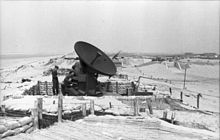
Flak units with the 8.8 cm flak in the versions 18, 36 and 37 were the backbone of the air defense in the bombing war that the Allies waged against German cities, industry and infrastructure. With the exception of naval locations, the 8.8 batteries were organizationally part of the Air Force .
The 8.8 proved itself at medium heights until the end of the war. Even if the flow of bombers was not stopped, the Allies lost a total of over 100,000 soldiers in the bomber war.
Dislocation; Flak halls as a lasting testimony to the air war
The weapon was used in batteries with four guns each and supplementary flak headlights . The 8.8 was not mounted on flak bunkers , but set up in use in the open. In August 1944, 10,930 guns, i.e. more than 2,500 flak batteries, were used in home air protection. For the time between the missions, standardized anti-aircraft halls were built for one battery each at all deployment points. Many of the anti-aircraft halls built in solid construction still exist today and bear witness to the aerial warfare almost everywhere in Germany. After the war, the part with the common rooms was often used as living space for the crew, while the actual hall was used by small businesses and craftsmen as a workshop. Fire brigades and clubs also use the old flak halls to this day.
Deployment tactics
In homeland security, up to ten batteries were combined to form large batteries under central command in order to increase the effectiveness of the main attack targets .
In general, the shooting was targeted. The determination of the speed and altitude of an enemy aircraft was carried out using an optical distance measurement ( triangulation ) when visibility was good . Flak searchlights were used for detection at night . The "command device" coupled with the range finder, a mechanical analog computer , calculated the lead and thus the duration of the projectile from the recorded values and the course of the machine . A clockwork (type ZtZ S / 30) developed by the Uhrwerke Gebr. Thiel (→ Gerätebau GmbH ) was built into the head of the grenade, which ignited the grenade after an adjustable running time of 1.5 to 29.5 seconds. Before firing, the delay time had to be set in the "fuse setting machine" on each grenade. In poor visibility conditions one had to rely on the values determined by the Würzburg radar units, which were transmitted electrically to the command unit. This could supply entire batteries from four or more anti-aircraft guns with elevation and lateral reference values via multi-core signal cables. Only if no corresponding data were available were sectors determined which the attackers would probably fly through and which were then simply permanently fired at ( barrage ).
Until shortly before the end of the war, the projectiles only had time fuses. However, it often happened that a shell struck an aircraft with almost no consequences and only exploded far behind. With the introduction of additional impact fuses (double fuses, dual fuses from Junghans ), which were not delivered until 1945 despite urgent requirements, the rate of firing could be roughly tripled.
The projectile had an effective radius of action of about ten meters or less against the robust B-17 . The flight times of the projectiles were 20 to 40 seconds, depending on the height. The measuring accuracy of the radar devices was roughly ± 100 meters if they were not disturbed. This meant that several thousand shells were needed to shoot down a bomber, which meant an enormous consumption of resources. An essential effect, however, was that the B-17 formations, when the anti-aircraft defense was strong, chose the greatest possible dropping height, which, however, significantly reduced the accuracy and effectiveness of the attack. When attacking in mixed formations of B-17 and B-24 Liberator, the B-17 exploited their superior climbing ability, which meant that the faster, but lower-flying and more sensitive to fire, the B-24 attracted the entire anti-aircraft fire and thus some sensitive Had losses.
Especially towards the end of the war, older youths, the so-called flak helpers , were used to a large extent to operate the flak. In December 1942, for example, 68,522 students were available for this. A total of over 200,000 students and apprentices participated in the flak service.
States of operations
-
 German Empire
German Empire
-
 Finland - 90 guns received from the German Reich in 1943/44
Finland - 90 guns received from the German Reich in 1943/44 -
 Yugoslavia
Yugoslavia
- Democratic Republic of Vietnam in the early 1960s
Museum reception
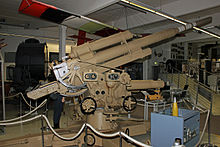
8.8 cm anti-aircraft guns are on display in the following museums :
- Imperial War Museum Duxford , Duxford, UK
- Imperial War Museum , London, UK
- Air Defense Museum, Tuusula , Finland
- United States Army Ordnance Museum , Aberdeen, Maryland , USA
- Canadian War Museum , Ottawa , Canada
- German Historical Museum , Berlin
- Military History Museum Berlin-Gatow Airfield , Berlin
- German Museum of Technology , Berlin
- German Tank Museum , Munster
- Aviation Museum Laatzen-Hannover , Laatzen
- Fort Kugelbake , Cuxhaven
- Museum for historical defense technology , Röthenbach / Pegnitz
- Stammheim Museum , Stammheim am Main
- Le Grand Bunker "Musée du Mur de l´ Atlantik", Ouistreham , France
- Swiss Military Museum Full , Switzerland
- Royal Danish Armory Museum , Copenhagen
- Fort Nelson, Hampshire
- Overloon War Museum , Netherlands
- Museo Histórico Militar, A Coruña , Spain
See also
literature
- TM E9-369A: German 88-mm Antiaircraft Gun material, detailed illustrated service u. Operating instructions (185 pages) (PDF; 12.42 MB).
- Janusz Piekałkiewicz : The 8.8 FlaK in ground combat. Motorbuch Verlag, ISBN 3-87943-423-9 .
- Chris Bishop (Ed.): Weapons of World War II - An Encyclopedia. Bechtermünz Verlag, ISBN 3-8289-5385-9 .
- Ian Hogg : 20th Century Artillery. Gondrom Verlag, ISBN 3-8112-1878-6 .
- Heinz J. Nowarra : The German Air Armament 1933-1945. Bernard & Graefe Verlag, ISBN 3-8289-5315-8 .
- Alexander Lüdeke : Weapons Technology in the Second World War. Parragon Verlag, ISBN 978-1-4054-8584-5 .
- OKW : Regulation D. (Air) T. 1101 - protective shield and hydraulic foot firing for 8.8 cm FlaK 18 and 36, preliminary description and installation instructions - 1941.
- Terry Gander, Peter Chamberlain: Encyclopedia of German Weapons 1939-1945. 2nd Edition. Special edition. Motorbuchverlag, Stuttgart 2006, ISBN 3-613-02481-0 .
- Werner Müller: The 8.8 cm FLAK 18–36–37–41. Volume 101, Podzun-Pallas Verlag.
- John Norris: 88 mm FlaK 18/36/37/41 and PaK 43 1936-45. Osprey Publishing, 2002, ISBN 978-1-84176-341-5 . (50 pages online PDF) ( Memento from May 15, 2018 in the Internet Archive )
Web links
- Page with detailed texts and many pictures
- Page with description of the command device
- VDI magazine January 1937 (outlines the state of the art at that time)
- Pictures of exhibits from the Museum of Historical Defense Technology
Individual evidence
- ↑ http://www.airpower.at/news03/0813_luftkrieg_ostmark/flaktuerme.htm
- ^ Army History Museum / Military History Institute (ed.): The Army History Museum in the Vienna Arsenal. Verlag Militaria , Vienna 2016, ISBN 978-3-902551-69-6 , p. 143
- ↑ www.lasegundaguerra.com

